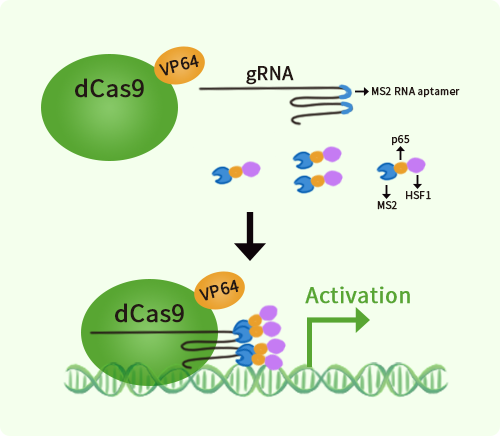Human Aconitase 1 (ACO1) activation kit by CRISPRa
CAT#: GA100036
ACO1 CRISPRa kit - CRISPR gene activation of human aconitase 1
Find the corresponding CRISPRi Inhibitor Kit
USD 1,290.00
2 Weeks*
Specifications
| Product Data | |
| Format | 3gRNAs, 1 scramble ctrl and 1 enhancer vector |
| Symbol | ACO1 |
| Locus ID | 48 |
| Kit Components | GA100036G1, Aconitase 1 gRNA vector 1 in pCas-Guide-GFP-CRISPRa GA100036G2, Aconitase 1 gRNA vector 2 in pCas-Guide-GFP-CRISPRa GA100036G3, Aconitase 1 gRNA vector 3 in pCas-Guide-GFP-CRISPRa 1 CRISPRa-Enhancer vector, SKU GE100056 1 CRISPRa scramble vector, SKU GE100077 |
| Disclaimer | The kit is designed based on the best knowledge of CRISPa SAM technology. The efficiency of the activation can be affected by many factors, including nucleosome occupancy status, chromatin structure and the gene expression level of the target, etc. |
| Reference Data | |
| RefSeq | NM_001278352, NM_002197, NM_001362840 |
| Synonyms | ACONS; HEL60; IREB1; IREBP; IREBP1; IRP1 |
| Summary | 'The protein encoded by this gene is a bifunctional, cytosolic protein that functions as an essential enzyme in the TCA cycle and interacts with mRNA to control the levels of iron inside cells. When cellular iron levels are high, this protein binds to a 4Fe-4S cluster and functions as an aconitase. Aconitases are iron-sulfur proteins that function to catalyze the conversion of citrate to isocitrate. When cellular iron levels are low, the protein binds to iron-responsive elements (IREs), which are stem-loop structures found in the 5' UTR of ferritin mRNA, and in the 3' UTR of transferrin receptor mRNA. When the protein binds to IRE, it results in repression of translation of ferritin mRNA, and inhibition of degradation of the otherwise rapidly degraded transferrin receptor mRNA. The encoded protein has been identified as a moonlighting protein based on its ability to perform mechanistically distinct functions. Alternative splicing results in multiple transcript variants [provided by RefSeq, Jan 2014]' |
Documents
| Product Manuals |
| FAQs |
Resources
Other Versions
| SKU | Description | Size | Price |
|---|---|---|---|
| KN201857 | ACO1 - human gene knockout kit via CRISPR, HDR mediated |
USD 1,290.00 |
|
| KN201857BN | ACO1 - human gene knockout kit via CRISPR, HDR mediated |
USD 1,290.00 |
|
| KN201857LP | ACO1 - human gene knockout kit via CRISPR, HDR mediated |
USD 1,290.00 |
|
| KN201857RB | ACO1 - human gene knockout kit via CRISPR, HDR mediated |
USD 1,290.00 |
|
| KN401857 | ACO1 - KN2.0, Human gene knockout kit via CRISPR, non-homology mediated. |
USD 1,290.00 |
{0} Product Review(s)
Be the first one to submit a review






























































































































































































































































 Germany
Germany
 Japan
Japan
 United Kingdom
United Kingdom
 China
China
